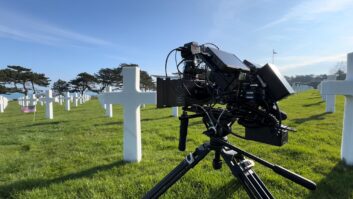The date is confirmed, the hats have been ordered, and the invitations have been dispatched, which means only one thing: the countdown to the Royal Wedding has begun.
At noon on Saturday, 19 May 2018, Prince Harry and Meghan Markle’s wedding service will commence at Windsor Castle. The world will be tuning in via any one of a number of live broadcasts that can be streamed straight to the viewer’s mobile phones or tablets.
A turning point for broadcast?
For the British public, a Royal Wedding means the syncing of television schedules, the hushing of children, and – occasionally – the raising of flags. This time around, however, the American public is likely to do the same in honour of Ms Markle, which means we can expect to see a significant increase in viewing figures in the United States. For broadcasters, this means an even more engaged global audience, and while it will be a greater opportunity for generating additional revenue, it also means an increasing number of demands from viewers.
Historically, Queen Elizabeth II’s coronation in 1953 – which allowed cameras into Westminster for the very first time – changed the face of broadcast forever. Pegged by many as “the day that changed television”, the ceremony was watched by an estimated 27 million people at television parties around the world. For the Royal Wedding, will viewers be huddled around one device as a family? Well, not necessarily. The golden age of television has come and gone. Today’s viewers, thanks to video streaming technology, have ushered in the golden age of mobile viewing.
In 2012, 24.5 million people watched Prince William and Kate Middleton tie the knot via terrestrial television. Those kind of viewing figures hadn’t been seen in the UK since the England football team won the World Cup final in 1966. Two billion people tuned in to watch the wedding the world over and blanket coverage of the event dominated TV schedules. Back then, just one million people used BBC iPlayer to stream coverage of the event but this time round those numbers will certainly grow this year given that, just last month, BBC iPlayer achieved its best ever February for viewing figures.
Mobile boom
The past decade has seen a boom in the number of people using their smartphone or tablet to stream video content in place of the traditional telly, laptop, or PC, and this is unlikely to slow down any time soon. In fact, according to Ooyala’s latest Global Video Index report, mobile devices now account for 60.3 per cent of video starts. Over-the-top video services have also doubled their hours of content offerings in recent months – with long-form content (content more than 20 minutes in length) increasing by an enormous 159 per cent, according to the same report – and it is the popularity of mobile-viewing when it comes to long-form content, that has driven the sudden increase.
Now that Samsung’s new Galaxy and Apple’s trio of new iPhones – the X, 8 and 8 Plus – have all upgraded screens, there is a push from mobile phone providers to encourage mobile viewing too. It is clear that companies like Apple are having to fill the demand for mobile viewing with technology that makes it easier for their consumers to watch content. For instance, networks are currently in the process of developing the new high-speed 5G connections and, as such, are paving the way for faster internet browsing, streaming and downloads on our mobile devices. This means that more 5G devices will start to appear as of next year and encourage even more users to stream video content straight to their mobile phone, on-the-go.
New challenges and new opportunities
The world of broadcasting is becoming more diversified. Events such as the Royal Wedding highlight a series of challengers for video producers across the spectrum. The entire content supply chain comes under pressure to deliver more content, distribute it more quickly, and do so in a more cost-effective, and time-efficient way.
In fact, the BBC, Sky News and ITV are all expected to cover the big day in the UK this year. The increase in broadcasters will mean much more competition for content producers, and much more audience demand for the best footage on the day as a result; and that demand will include broadcasters around the world. Similarly, there’s no doubt that this live footage will then need to be archived (quickly and effectively at that) to be used again years into the future, especially for broadcasters who run news programmes.
While the Royal Wedding will generally be a fantastic event, content producers must find a way to simplify and streamline the process of managing, curating, orchestrating, publishing, measuring and monetising video content in an ever more competitive video environment.
Staying ahead of the content curve
So, what could this mean for the Royal Wedding of the future? Well, 5G will certainly become a catalyst for even more people to tune in via their smartphone or tablet. It is strange to imagine that when Prince William and Kate Middleton married, for example, mobile phone users only had access to 3G…now 4G is commonplace on any network. We can expect the same for 5G network access in the coming years. AI (artificial intelligence) also could play a major role, allowing broadcasters to store, archive – and retrieve – relevant clips and footage much more quickly and cleanly.
Until the next wedding, however, Harry and Meghan can expect to make history – at least for now – for mobile viewing figures around the world.





